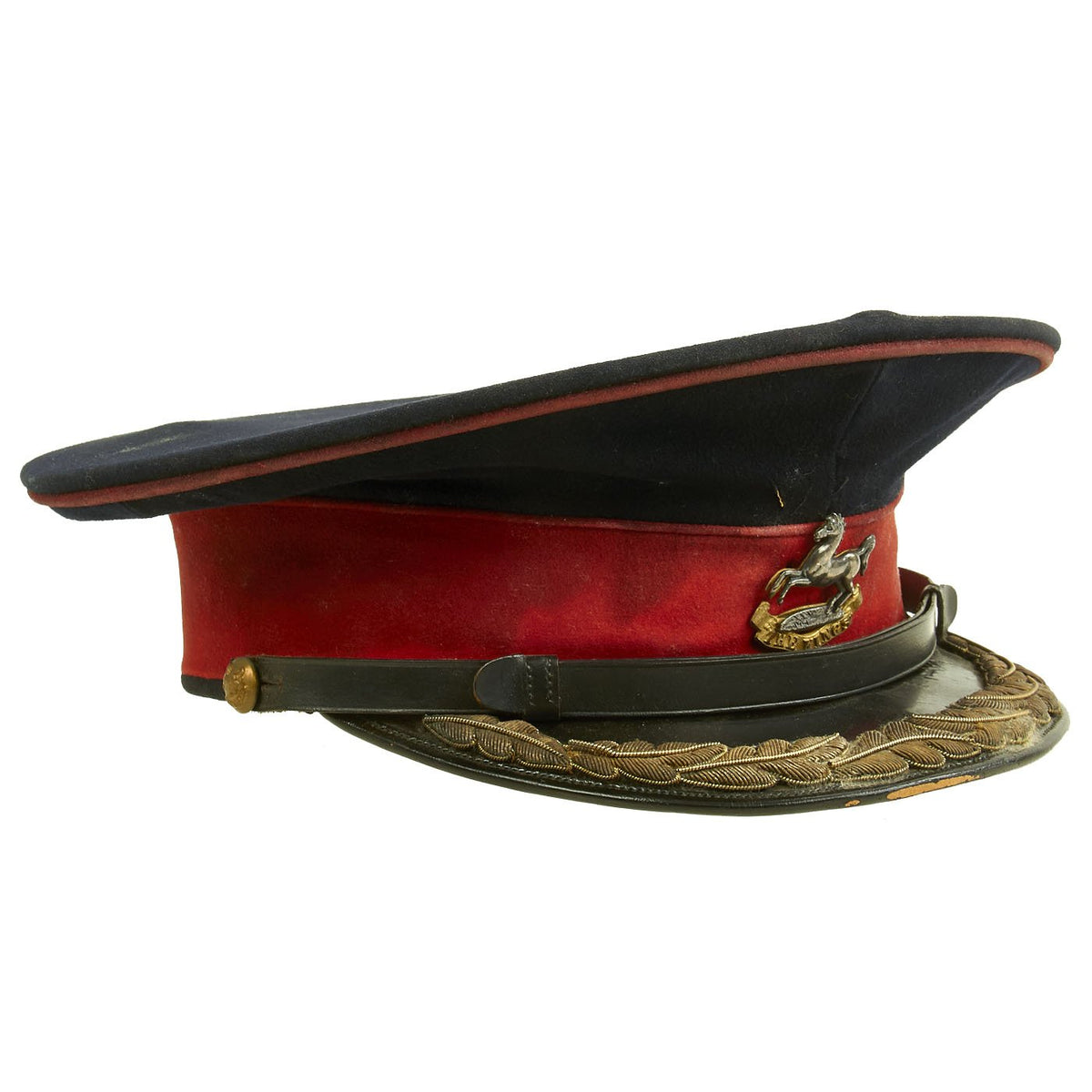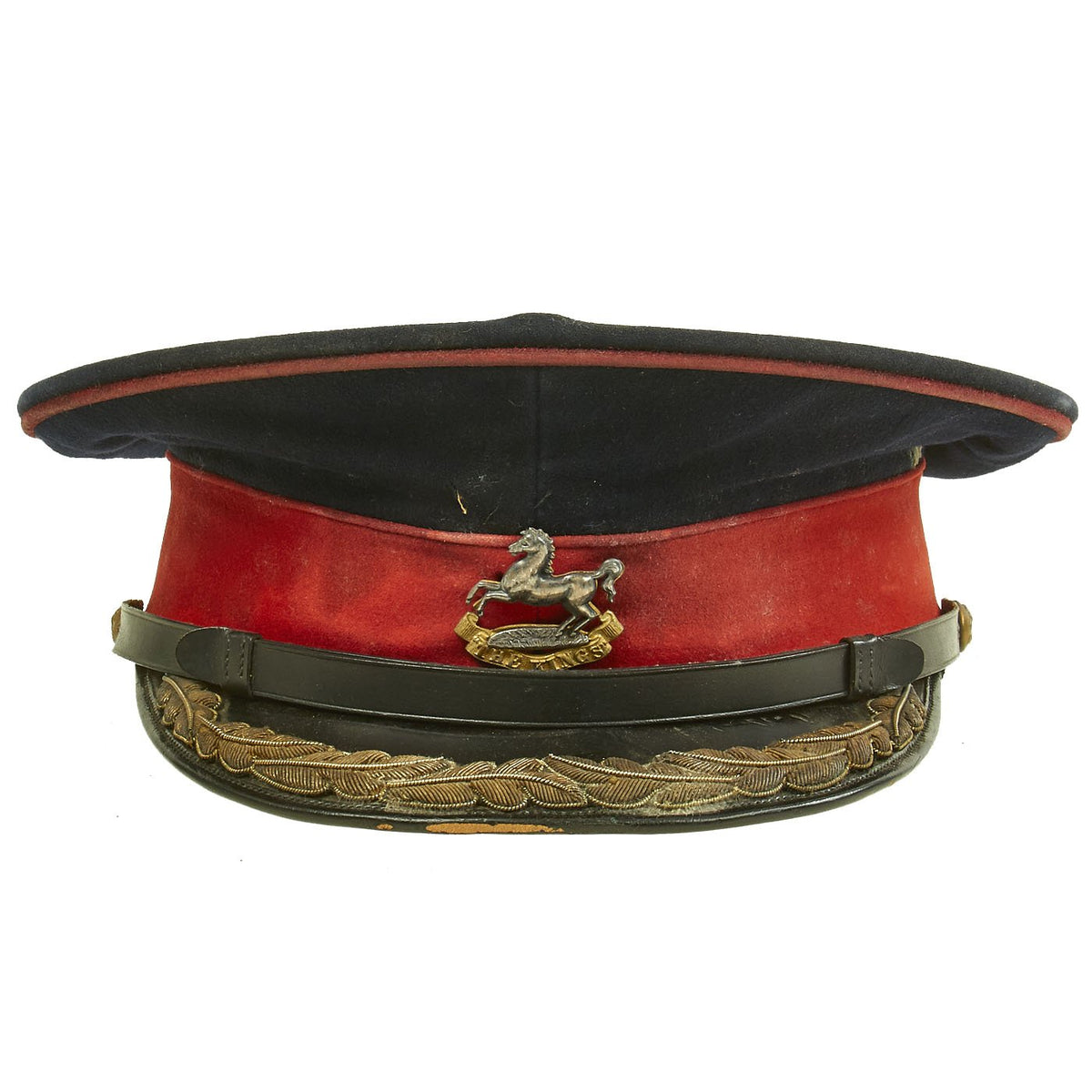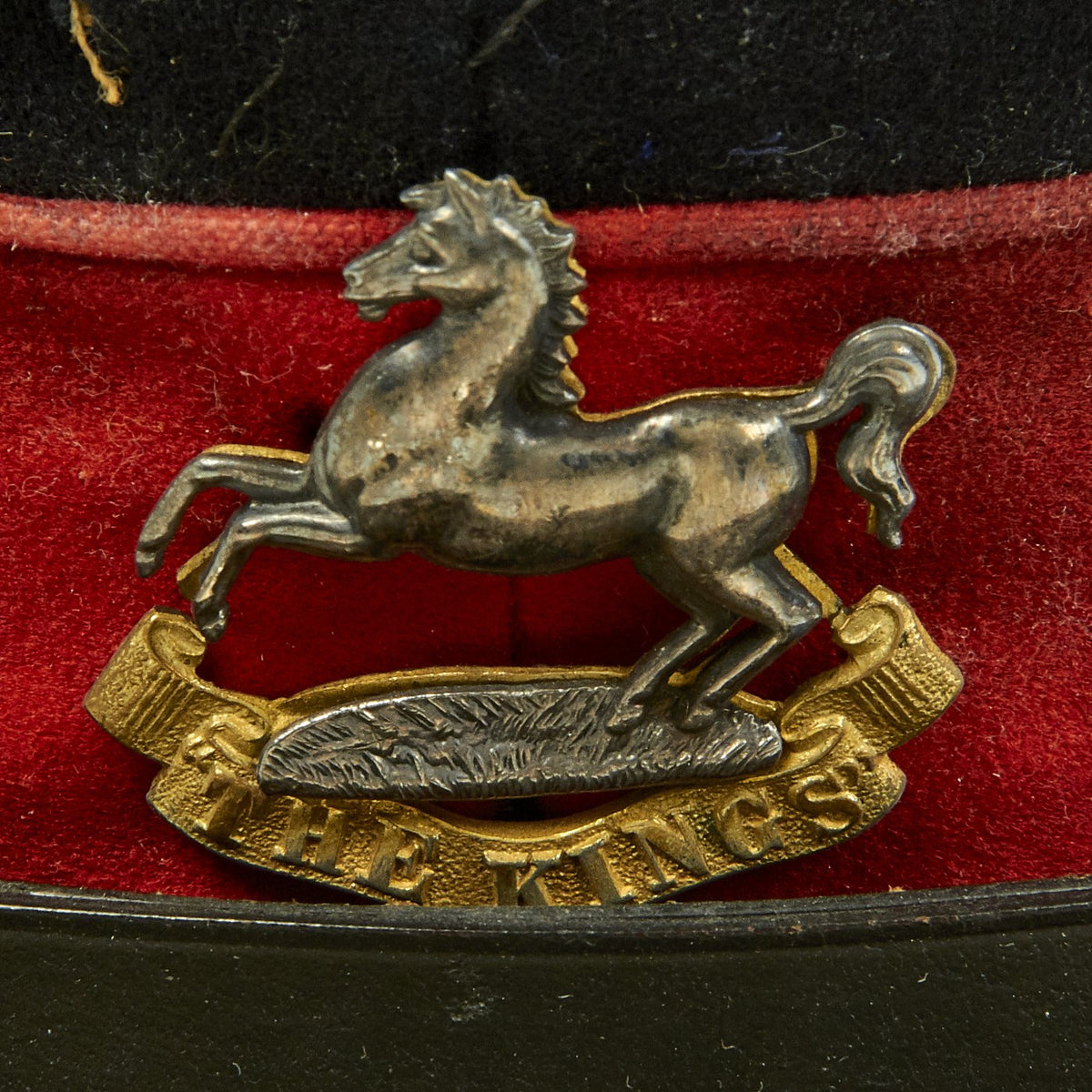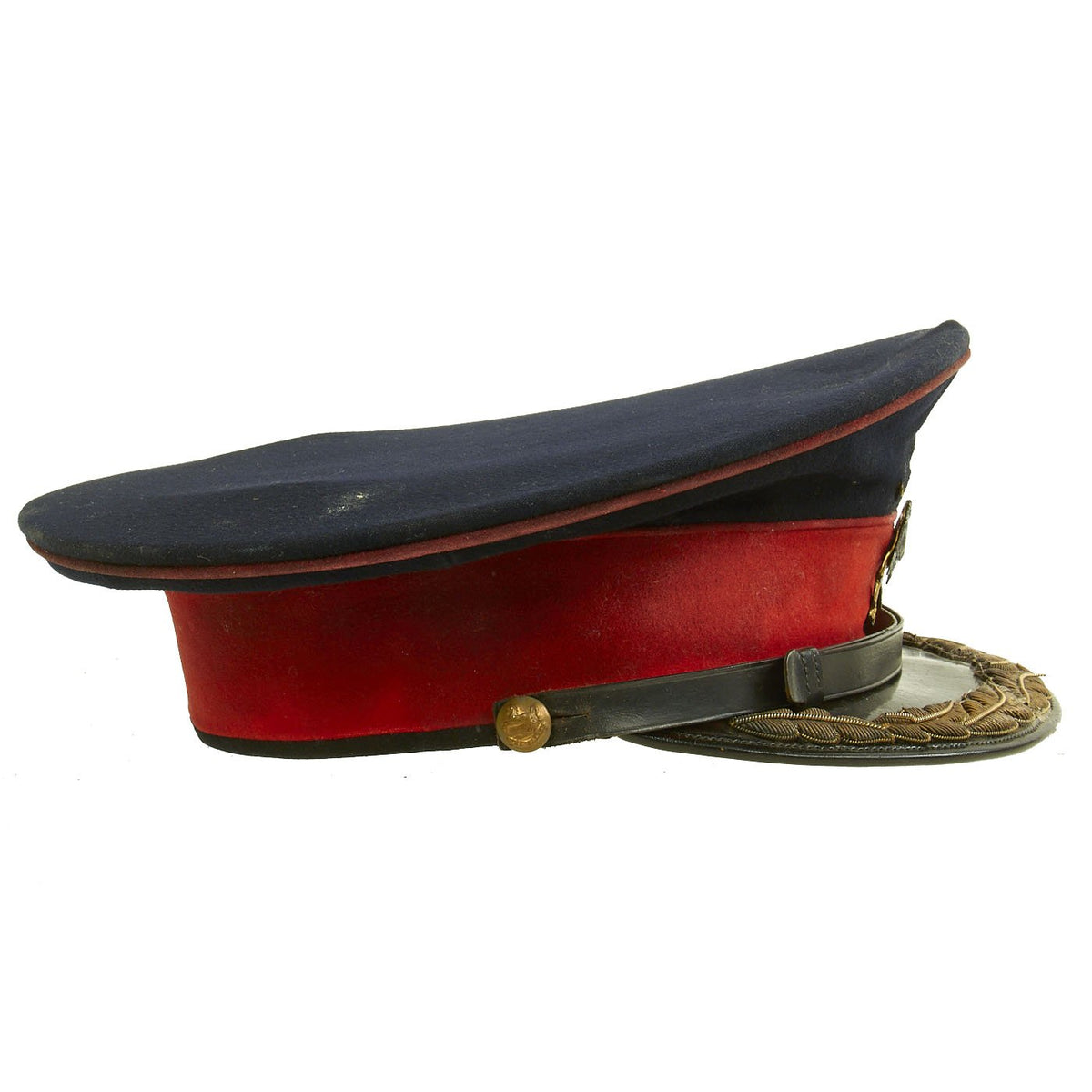Original British WWII The King’s Liverpool Regiment Colonel Parade Visor Cap Original Items
$ 195,00 $ 78,00
Original Item: Only One Available. This WW2 dress officer’s parade visor cap is in very good condition. Blue wool body is unblemished, with good piping and color, and no mothing whatsoever. The King’s Liverpool Regiment hat badge and chinstrap buttons. The leather chin strap itself shows no cracking or wear.
Composite visor has heavy bullion wire embroidery laurel leaves on the edge denoting the rank of Colonel. Original leather sweatband is embossed:
HAWKES’S PATENT SELF-FITTING AND VENTILATING DEVICE FOR HEADWEAR
This patent was Patented July 31, 1917.
Crown is maker marked:
HAWKES & CO. LTD
I, SAVILLE ROW W
Overall condition is very good, size is approximately US 7 (56cm).
The Regiment was first formed in 1685 as ‘Princess Anne of Denmark’s Regiment of Foot’ after King James II’s second daughter (later Queen Anne). It was formed in response to the Monmouth Rebellion of 1685 when, James Scott the 1st Duke of Monmouth (the oldest illegitimate son of Charles II and James II’s nephew) unsuccessfully attempted to overthrow the unpopular King. His small force was swiftly put down at the Battle of Sedgemoor. The Regiment was under the command of James FitzJames, 1st Duke of Berwick; the illegitimate son of King James II. In 1688 James II fled to France when Prince William of Orange was invited by the English Lords to become King William III. The Duke of Berwick decided to follow his father into exile and was replaced by Colonel John Beamon as the commanding officer of the Regiment.
As one of the oldest Regiments in the British army it took part in much of British Military History including the War of the Spanish Succession (1701-1714), fighting at Nijmegen, the capture of Huy and Limbourg, the capture of the Schellenberg fortress, the Battle of Blenheim, the Battle of Ramillies, the Battle of Oudenarde, the sieges of Ghent, Bruges and Lillie, the Siege of Tournai, and the Battle of Malplaquet.
When Princess Anne ascended to the throne in 1702 the Regiment became the Queen’s Regiment of Foot. A Jacobite rebellion followed in 1715 when Queen Anne died. The Jacobite supporters hoped to install James Stuart (the legitimate son of James II of England) to the throne instead of the Hanoverian King George I. As unrest escalated in Britain, the Queen’s Regiment fought against the numerically superior Jacobite army at the Battle of Sheriffmuir and succeeded in suppressing the rebellion. To honour the Regiment’s service to King George I, the Queen’s became the King’s Regiment of Foot with the White Horse of Hanover as its badge. The Regiment then remained on garrison duties in Scotland and England until 1739.
The Regiment went on to serve during the War of the Austrian Succession (1740–48) fighting at the Battle of Fontenoy (1743) and the Battle of Dettingen. Until 1745 when the Regiment returned to Britain in a hurry in order to fight in the second Jacobite Rebellion, when Bonnie Prince Charlie (the grandson of James II) landed in Scotland, again attempting to regain the lost crown to the Stuart family. The Regiment fought at the Battles of Falkirk and Culloden.
It went on to serve during the American Revolutionary War (1768-1785), and during the Napoleonic Wars (1803–1815) seized the Island of Martinique in the West Indies. It suffered 1,700 casualties in the first 9 months of 5 year deployment in the West Indies, largely due to disease.
The War of 1812 was a 32-month military conflict between the United States and the British Empire resolving many of the remaining issues of the American War of Independence, fighting at the attack at Ogdensburg, the Battle of Chippewa, the Battle of Lundy’s Lane, action at Snake Hill and the siege of Fort Erie. The Regiment then went on to served during the Indian Mutiny of 1857 where it was stationed at Jullundur. A detachment of the regiment performed an important service by securing the fort and magazine at Phillour. They marched from Jullundur to Delhi, in fourteen days, and with bayonet and rifle helped to clear the city of the mutineers. They took part in the relief of Agra, where they defeated 8,000 mutineers and captured all their guns. They then proceeded to the relief of Lucknow and took part in other operations.
They were active in the Second Afghan War (1878–1880) and then went on to serve during the Third Burmese War (1885), Second Boer War (1899-1902), and the two World Wars.
In 1958 after 273 years of continuous existence, the Regiment was amalgamated with the Manchester Regiment, and became The King’s Regiment (Manchester and Liverpool). In 2004 the British infantry was restructured once again and the King’s Regiment was merged with King’s Own Royal Border Regiment and The Queen’s Lancashire Regiment to form The Duke of Lancaster’s Regiment (King’s, Lancashire and Border). It
Fast Shipping with Professional Packaging
Thanks to our longstanding association with UPS FedEx DHL, and other major international carriers, we are able to provide a range of shipping options. Our warehouse staff is expertly trained and will wrap your products according to our exact and precise specifications. Prior to shipping, your goods will be thoroughly examined and securely secured. We ship to thousands clients each day across multiple countries. This shows how we're dedicated to be the largest retailer on the internet. Warehouses and distribution centres can be located throughout Europe as well as the USA.
Note: Orders with more than one item will be assigned a processing date depending on the item.
Before shipping before shipping, we'll conduct a thorough inspection of the items you have ordered. Today, the majority of orders will be delivered within 48 hours. The delivery time will be between 3-7 days.
Returns
The stock is dynamic and we cannot completely manage it because multiple stakeholders are involved, including our factory and warehouse. So the actual stock may alter at any time. It's possible that you may not receive your order once the order has been made.
Our policy is valid for a period of 30 days. If you don't receive the product within 30 days, we are not able to issue a refund or an exchange.
You can only return an item if it is unused and in the same state as the day you received it. You must have the item in its original packaging.
Related products
Uncategorized
Uncategorized
Uncategorized
Uncategorized
Uncategorized
Uncategorized
Uncategorized
Uncategorized
Uncategorized
Uncategorized
Uncategorized
Uncategorized
Armoured Fighting Vehicles of the World: AFVs of World War One (Hardcover Book) New Made Items
Uncategorized
Uncategorized
Uncategorized
Uncategorized
Uncategorized
Angolan Rebel 1970s era 60mm Inert Display Mortar from Angolan Civil War Original Items
Uncategorized
Uncategorized












































































